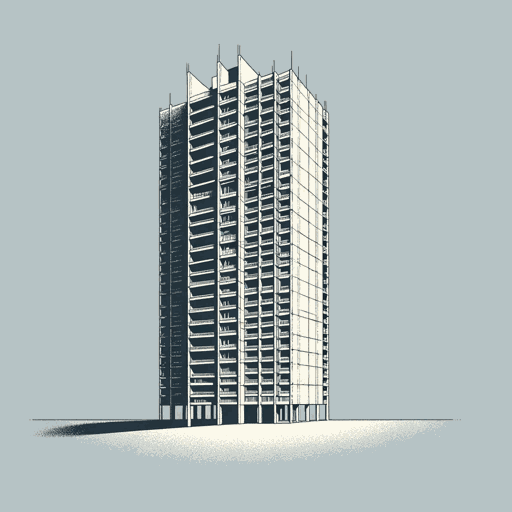52 pages • 1 hour read
J. G. BallardHigh-Rise
Fiction | Novel | Adult | Published in 1975A modern alternative to SparkNotes and CliffsNotes, SuperSummary offers high-quality Study Guides with detailed chapter summaries and analysis of major themes, characters, and more.
Summary and Study Guide
Overview
High-Rise is a 1975 speculative novel by English author J. G. Ballard. The story explores the psychological effect of living in a Brutalist high-rise in a new development outside London. The private, pseudo-luxury living the building affords to its bourgeois tenants quickly pushes them into violent conflicts with each other and the building itself. The residents embrace these conflicts as an escape from their sterile, eventless lives, seeking self-realization in the disintegration of their environment and social relations. As they descend further and further into primal territorialism and extreme violence, a multifactional group of women plot to restore order and defeat the increasingly feral men.
This guide references the 2012 Liveright paperback edition.
Content Warning: The source material features graphic depictions of sexual assault, violence, neglect, and cruelty to animals.
In a flash-forward three months after the start of the building’s descent into violence, Dr. Robert Laing sits on his 25th-floor balcony roasting the Alsatian dog of the building’s now deceased architect and penthouse resident, Anthony Royal. Content for the first time in his life, Laing reflects on how this new normal came to be.
Following his sister Alice’s advice, the 30-year-old Laing moves to the isolated development after his divorce, seeking a fresh start amid the private luxury of the 40-floor Brutalist building. Initially, the building alienates Laing. However, he gradually begins to embrace this hostile environment as a stage for indulging his repressed impulses. Despite his best attempts, Laing is quickly embroiled in the petty disputes provoked by the building’s shoddy construction and hierarchical design. As his neighbors rebel with aggressive partying and violence against the building and each other, Laing finds himself welcoming this descent into chaos.
The residents split into clans based on floor number. More broadly, the socioeconomically homogenous group of professionals splits into three social classes: lower, middle, and upper. This stratification is driven in part by the high-rise itself, which affords certain privileges to the upper-floor tenants while denying them to others. Every night, as darkness falls these clans fight for territory.
As the violence escalates, the residents become increasingly isolated from the outside world. First, a brash second-floor documentarian, Richard Wilder, drowns the dog of a top-floor resident. Then, a 40th-floor jeweler falls (or is pushed) to his death. The violence and vandalism, which mostly occur after dark, begin to bleed into the daytime. Fewer and fewer residents leave for work every day. Residents stop inviting outside friends to the building, and eventually the high-rise becomes fully isolated.
Wilder begins shooting a documentary on life in the high-rise. Many residents film fights to rewatch later in the building’s cinema. The violence becomes increasingly stylized, as if the tenants are tailoring it for the cameras. Wilder abandons his family to undertake a mythical and increasingly irrational quest to summit the building.
After initially lamenting the destruction of his prize building, Royal embraces its disintegration, seeing in it the promise of rebirth. He begins spending time with the flock of gulls that descends to scavenge the growing piles of garbage on the roof, fantasizing that they will sweep through the building in a cleansing, prehistoric wave.
The clans disband, replaced by disparate groups that barricade themselves inside individual apartments. Fighting decreases, but what violence remains becomes more extreme. While his neighbors move upward, seeking safety, Laing remains on the 25th floor, sequestering himself with a film critic named Eleanor Powell and his sister, Alice, for whom he’s developed a sexual attraction. Deprived of the dogs that provide sustenance to the middle and upper floors, the lower-floor residents begin resorting to cannibalism.
As everyone sequesters themselves, Wilder continues his ascent of the building. He fails to notice that a women’s commune—formed for protection against the increasingly feral men—has cleaned the upper floors of graffiti and garbage. When Wilder summits, he encounters Royal in his penthouse. The architect attacks him, and Wilder shoots him.
Royal crawls down the building to die in the mass grave made of the 10th-floor pool; Wilder steps onto the roof, where he finds a group of well-dressed female residents—including his wife, Helen, and middle-floor resident Charlotte Melville—supervising a group of children playing with bones. In his final regression to childhood, Wilder totters forward to join his playmates. As he does, the women encircle Wilder, drawing knives. It’s implied that the group slaughters and eats Wilder.
Floors below, Laing finishes cooking Royal’s Alsatian for his sister and Eleanor. The women discuss expelling Laing; he plans with pleasure for ways to avoid this. Laing looks forward to restoring his apartment and floor, as he’s noticed his female neighbors doing. Across the development, the second high-rise experiences its first blackout.
Related Titles
By J. G. Ballard




